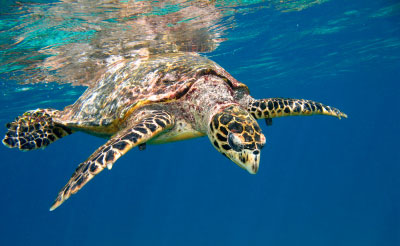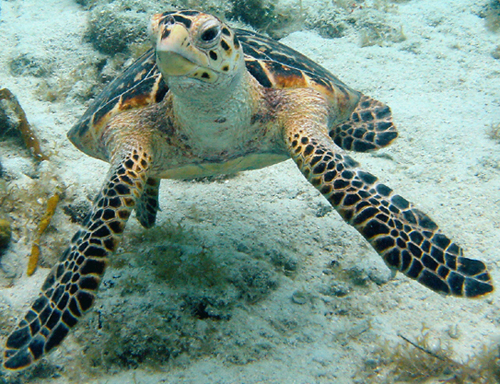Field Guide to Maryland's Turtles (Order Testudines)
Main_Content
Hawksbill Sea Turtle (Eretmochelys imbricata) | | Common Name:
|

Photo courtesy of iStock
|
Size: 30-35 inches. Record - 44 inches |
Appearance:
- A brown, greenish-brown or black carapace (top shell) which is
shield-shaped and flattened.
- Smaller individuals may have a “tortoise shell” pattern
(combinations of amber, brown and black), which is the source of the
commercial product.
- The plastron (bottom shell), chin and throat are yellow.
- The carapace has a keel down its center, with serrations along the
rear margin.
- The scutes overlap like shingles, except in older specimens.
- Four costal scutes on each side of the carapace. The first costal
scute does not touch the nuchal scute.
- Two pairs of scales between eyes (vs. one pair in Green seaturtle).

Photo of Hawksbill Sea Turtle, courtesy of Caroline Rogers, USGS
|
Habitats:Primarily a tropical species, where it is found only in marine environments, particularly shallow areas of rocky coastlines, coral reefs, estuaries and lagoons with mud bottoms. The key is shallow areas with little or no vegetation. No nesting occurs at our latitude.
|
How to Find:An extremely rare visitor to our shores. Little is known about this turtle’s behavior due to its solitary nature, even when nesting. Look in the Coastal Bays for individuals resting on the bottom in clear water during the summer.
|
Distribution in Maryland:Coastal Bays of Worcester County. This turtle is listed as Federally and State Endangered. If found, please report sightings to the Maryland Wildlife and Heritage Service. If found stranded or dead, please report sightings
|
|
